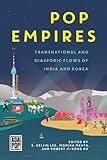Pop Empires : Transnational and Diasporic Flows of India and Korea / ed. by Monika Mehta, Robert Ji-Song Ku, Allison Alexy, S. Heijin Lee.
Material type: TextSeries: Asia Pop!Publisher: Honolulu : University of Hawaii Press, [2019]Copyright date: ©2019Description: 1 online resource (360 p.) : 15 b&w illustrationsContent type:
TextSeries: Asia Pop!Publisher: Honolulu : University of Hawaii Press, [2019]Copyright date: ©2019Description: 1 online resource (360 p.) : 15 b&w illustrationsContent type: - 9780824878016
- 9780824879921
- Culture in motion pictures
- Motion picture industry -- India -- Mumbai
- Motion picture industry -- Korea (South)
- Motion picture industry-India-Mumbai
- Motion picture industry-Korea (South)
- Motion pictures and transnationalism
- Motion pictures, Indic
- Motion pictures, Korean
- SOCIAL SCIENCE / Popular Culture
- 384/.80954792 23
- PN1993.5.I8 P655 2019
- online - DeGruyter
- Issued also in print.
| Item type | Current library | Call number | URL | Status | Notes | Barcode | |
|---|---|---|---|---|---|---|---|
 eBook
eBook
|
Biblioteca "Angelicum" Pont. Univ. S.Tommaso d'Aquino Nuvola online | online - DeGruyter (Browse shelf(Opens below)) | Online access | Not for loan (Accesso limitato) | Accesso per gli utenti autorizzati / Access for authorized users | (dgr)9780824879921 |
Frontmatter -- Contents -- Series Editor's Preface -- Acknowledgments -- Introduction -- Part I: Queering Routes and Roots -- Introduction -- 1. The Softening of Butches: The Adoption of Korean "Soft" Masculinity among Thai Toms -- 2. Between Screens and Bodies: New Queer Performance in India -- 3. K-pop in Mexico: Flash Mobs, Media Stunts, and the Momentum of Global Mutual Recognition -- 4. Making the Past Present: Intertextuality and Pastiche in Bollywood Neo-Noir -- Part II: Relocating Stardom -- Introduction -- 5. The Politics and Promises of "Gangnam Style" -- 6. Ranveer Singh's "Chichorapan": Habitus, Masculinity, and Stardom -- 7. Consolidating Bollywood: Spectacularity without Stardom -- 8. Imitating Flower Boy Stars: K-pop Male Stars and Assembling New Female Masculinity in South Korea -- Part III: (Not) Crossing Over -- Introduction -- 9. Expanding Diasporic Identity through Bollywood Dance in London -- 10. From Seoul to Cinemascapes: The Private Lives of Contemporary Cine-Tourism in (and out) of India -- 11. Hallyu in Hollywood: South Korean Actors in the United States -- 12. Sassy Girls: A Transnational Reading of the Monstrous Girlfriend in South Korea, India, and the United States -- Part IV: Mediating Circuits and Markets -- Introduction -- 13. Imagining Virtual Audiences: Digital Distribution, Global Media, and Online Fandom -- 14. How K-pop Went Global: Digitization and the Market-Making of Korean Entertainment Houses -- 15. Toward a Global Community: Dreaming High with K-pop -- 16. Thinking Outside the Canvas: The Lost Art of Cinema Billboards in South Korea and India -- Bibliography -- Contributors -- Index
restricted access online access with authorization star
http://purl.org/coar/access_right/c_16ec
At the start of the twenty-first century challenges to the global hegemony of U.S. culture are more apparent than ever. Two of the contenders vying for the hearts, minds, bandwidths, and pocketbooks of the world's consumers of culture (principally, popular culture) are India and South Korea. "Bollywood" and "Hallyu" are increasingly competing with "Hollywood"-either replacing it or filling a void in places where it never held sway. This critical multidisciplinary anthology places the mediascapes of India (the site of Bollywood), South Korea (fountainhead of Hallyu, aka the Korean Wave), and the United States (the site of Hollywood) in comparative dialogue to explore the transnational flows of technology, capital, and labor. It asks what sorts of political and economic shifts have occurred to make India and South Korea important alternative nodes of techno-cultural production, consumption, and contestation. By adopting comparative perspectives and mobile methodologies and linking popular culture to the industries that produce it as well as the industries it supports, Pop Empires connects films, music, television serials, stardom, and fandom to nation-building, diasporic identity formation, and transnational capital and labor. Additionally, via the juxtaposition of Bollywood and Hallyu, as not only synecdoches of national affiliation but also discursive case studies, the contributors examine how popular culture intersects with race, gender, and empire in relation to the global movement of peoples, goods, and ideas.
Issued also in print.
Mode of access: Internet via World Wide Web.
In English.
Description based on online resource; title from PDF title page (publisher's Web site, viewed 02. Mrz 2022)


